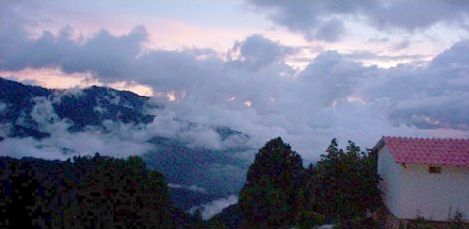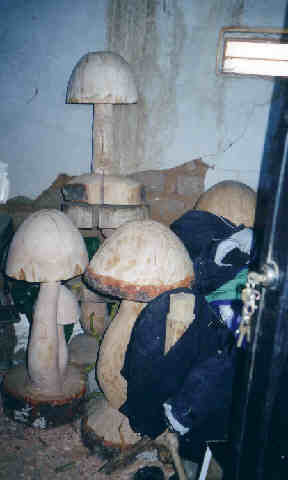

Although they are not a local band, it is an appropriate choice for the town since that is also the name of its best known tourist attraction: the Atotonilco Hot Springs. (Actually there are several Atotonilcos, which is the nahua word for these thermal sulphurous waters, which were revered - - and still are - - for their curative propeties.)
The springs are about an hour and a half on foot or horseback from the town and getting there is half the enjoyment.
San José Manialtepec sits on the banks of the Manialtepec River which will be an almost constant companion on the trip up to Atotonilco. Leaving the town, you ride over the levee and cross the river, passing women and children bathing, washing clothes or just playing and relaxing in the water. This is the first of six times that the river must be passed to get to your destination.
Soon the path is protected by leafy trees called "Brasil" and "Cacahuanano" which offer welcome shade. You'll ride through Paso el Pedregoso, Rocky Pass, Then the river snakes its way through craggy cliffs, including a great rock formation called Eagle Peak. You'll see some enormous Macahuite trees in which termites have made great nests. Abandoned by those voracious insects, they are now home to swarms of parakeets whose cries fill the air.
A small, rustic chapel for the Virgin of Juquila stands guard over the springs which run down through the rocks feeding into a small pool, where, if you can tolerate the heat, you can immerse yourself in the steamy, sulfur-rich water. After resting and enjoying the healing benefits of this ancient gift of nature, you'll return through the beauty of the hills and plains, carpeted with tropical lushness, that few visitors get to see.
If you'd like to take a guided horse ride to Atotonilco, you can arrange a trip with Sr. Jesús "Chucho" Villavicencio and he'll have the horses ready when you arrive. Call the local radio phone caseta: 01 200 123 7325. They'll page him by loud speaker, which is how most people receive their calls in small towns without cellular or landline service. The cost is $120 to $150 pesos per person.
San José Manialtepec is about 10 minutes beyond the last resort on the Lagoon. Look for the turnoff just before the bridge.
200 meters before the turnoff is the dirt road that leads to Puerto Suelo on the banks of the river where it enters the lagoon. The road has recently been graded and is now passable for all vehicles. It's a lovely spot, please respect it.
 You couldn't find an environment more different from the tropical
languor of the Oaxacan coast, than the breathtaking vistas of forested
peaks among the clouds in the high Southern Sierra.
You couldn't find an environment more different from the tropical
languor of the Oaxacan coast, than the breathtaking vistas of forested
peaks among the clouds in the high Southern Sierra.
San José del Pacífico is a beautiful town, 8400 feet above us, but only a three hour-or-so drive. It's a favorite place to stop overnight on the drive between Oaxaca City and the coast via Pochutla to Miahuatlan. But this town is worth a trip in itself.
The fiesta for its patron saint is centered around the small plaza by the old church and civic buildings perched high above Highway 175, which is where most of the restaurants and other services are concentrated and all most visitors get to see of the town.
Be prepared for a totally different climate, especially this time of year. The cold evenings will come as a shock after the balmy nights of Puerto. If you want to go out at night to attend any of the fiesta activities, bundle up, otherwise you'll be miserable. In fact in winter it doesn't really warm up until midday.
The best place to stay is in the charming rustic cabins perched on the hillside at La Puesta del Sol. They have private bathrooms and lots of hot water and a fireplace with kindling and logs to survive the night and for $450 pesos. Its can make for a romantic overnight stay, if you've got someone to cuddle up with.
 (In summer months, the cool maintain climate offers a welcome respite
from the intense swelter of the coast.) The hotel has an adequate
restaurant and bar. You can make a reservation by calling (01) 951
547-4225 or through their website: www.sanjosedelpacifico.com
(In summer months, the cool maintain climate offers a welcome respite
from the intense swelter of the coast.) The hotel has an adequate
restaurant and bar. You can make a reservation by calling (01) 951
547-4225 or through their website: www.sanjosedelpacifico.com
There's great hiking and birding among the trails through pine forests. But, San José del Pacífico is also known for its psilocybin mushrooms and attracts those looking to sample its hallucinogenic effects. That's why the gift shops offer wooden and ceramic representations of the these fungi, alongside the woolen gloves, hats, sweaters and shawls.
Mushroom season corresponds with the rainy season, roughly July to October, but they are often available year around, preserved in honey. Mushrooms and their healing and visionary properties have long played a role in the culture of the handsome local Zapotec people in this land of the clouds. But you should be aware that they are an illegal, controlled substance under Méxican law.
The drive up to San José del Pacífico is magnificent. As you begin to climb from Pochutla, you'll pass through Chacalapa, another town which has adopted Saint Joseph as its patron.
At 300 meters in altitude, the landscape is still tropically lush, but it's somewhat cooler than the coast. There is a pleasant restaurant with a pool called Los Reyes on the highway. And you can ask for directions to Rancho Alegre, a slice of Eden, full of mango, avocado, lime, banana, cocoa and zapote trees, bamboo, coffee, as well as flowering plants such as ginger, King's scepter, bird of paradise, philodendron, hyacinth, mother-in-law tongue, hibiscus, bromeliads, bougainvillea, mandevilla.
They occasionally accept overnight guests. There are also rooms available at the pool resort El Paraiso, which is a short walk down the road. You can hike to the waterfalls and the sulphur springs and enjoy homegrown produce and coffee.
Established in 1937, the Chacahua Park is one of the oldest in México and its 19 miles of sea shore, six island-dotted lagoons, river channels and mangrove forests comprise one of the most important wetland complexes on the Oaxacan coast.
Most visitors to the park get there through the village of Zapotalito, on a much shorter road that leaves the Coast Highway a few minutes past the town of Rio Grande. There you can around arrange a tour of the park or take a water taxi to Chacahua or the beautiful beach at Cerro Hermoso.
But for the adventurous and those with their own vehicle, the San José del Progreso option, another 30 minutes further down the highway, beyond Santa Rosa de Lima and the turn off for San PedroTututepec, the offers direct access to the heart of the park.
(There is now also regular collective taxi service from San José out to Chacahua village.) If you want to visit Cerro Hermosa beach or take advantage of the great surfing beyond, or visit the other part of Chacahua across the river channel, where the park visitor center and its crocodile hatchery are located, you'll still have to take a water taxi.
There are some rudimentary hotels, cabañas and camping sites available,
as well as fairly decent restaurants where you can enjoy the bounteous
gifts of the rich biodiversity of this environment, from fresh sea bass,
red snapper and grouper to clams, mussels and crab.